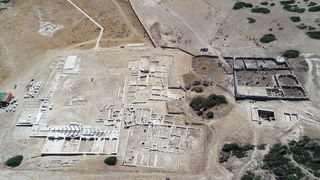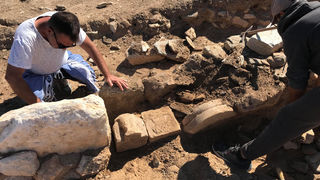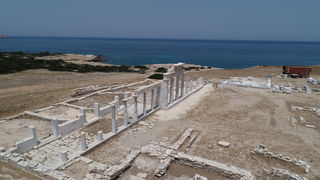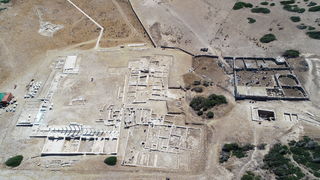Systematic Excavation and Restoration Project 2022 at Despotiko

This year, the excavation work at Despotiko, Mantra site, lasted for six weeks, from 22 May to 1 July 2022. An extensive installation, and one of the most important cult centres in the central Aegean, has come to light at this site, which has been excavated since 1997. The earliest evidence of activity dates back to the Early Iron Age, while the period of peak activity is documented around the mid-6th century BC, with the establishment of the 1600m2 shrine (‘temenos’) of Apollo, surrounded by a wall (‘peribolos’). The excavation has so far revealed 88 fragments of marble ‘kouroi’ (free-standing sculptures) and 40 marble pedestals for statues of different types, which are the most impressive offerings in the sanctuary, constituting the largest known set in the Cyclades. Outside the temenos, there is a large complex of structures and building complexes of various uses (residences, restaurants, warehouses, animal keeping areas, etc.). The discovery, in 2020, of an extensive and complex water collection and management system consisting of cisterns and a built pipeline, which extended to the foothills of the hill south of the sanctuary, is indicative of the size of this facility.
Excavation: This year’s excavation work focused on the cistern system, as well as the area south of the temenos, the Eastern Complex and Building U.
In particular, the excavation of the central cistern (Cistern 1) and the southernmost circular cistern (Cistern 3) continued.
The surviving architectural remains point to at least two architectural eras of the central cistern in ancient times.
- Its initial plan was rectangular, its internal dimensions being 5.50 x 7m; it was about 4m deep, with a capacity of 154 cubic metres. Last year, only the southern and eastern walls had been fully uncovered, but this year – after particularly painstaking and demanding work – the northern and western walls of its initial era were uncovered in their entire length and height.
- All walls are particularly robust, about 0.70-0.80m wide. The natural topography and an existing natural cavity seem to have been used for their construction. The 0.40m high foundation is particularly robust and protrudes from the superstructure by about 0.10m, consisting of large gneiss slabs of 0.50-0.80m. The upper part of the walls was built with rectangular gneiss stones which are 0.10-0.15m thick and 0.20-0.30m long. The construction is particularly meticulous with very few gaps in the joints between the stones. The surface of the stones was not smoothened, probably deliberately, so that the thick, off-white-coloured hydraulic mortar that covered the entire surface of the walls would fit better between the joints.
- The bottom of the cistern is coated with the same mortar. Part of it survives in fairly good condition along the eastern and southern walls.
- After the removal of stones and soil that had collapsed above and in front of the north and west walls, a U-shaped structure, part of which had been uncovered in 2021 adjacent to and along the north and east walls of the cistern, came to light.
- Its northern side survives at a height of 0.80m and width of 0.60m. It consists of three rows of rectangular blocks with elaborate surfaces imitating the isodomic masonry system. The mortar lining can still be seen in their lower part.
- The same method of construction was used for the eastern and western parts of the structure, which survive to a lesser extent lengthwise. The upper surface of the three sides of the structure is made of flat slabs, which could possibly mean that the structure was used as a bench.
The exploration of the inner part of the circular Cistern 3, discovered in 2021, continued.
- Due to the volume of the fill, it was decided to open a 0.50m wide test cut across its inner side to reveal the internal surface of the masonry.
- At a distance of almost 1.5m west of its southern opening and at a slightly higher level, a section of a rectangular, shallow building was found which appears to be divided into two parts (east and west). This could be a small cistern or pit, although further research would be needed in order to confirm this.
In the Eastern Complex, the exploration continued in the south-western part of the complex, where part of a large, paved area had already been revealed. A rectangular room to the south of the paved area was explored and it became clear that the areas of the Complex extend further to the south and to the east.
Considerable emphasis was placed on the excavation of the area to the south of the temple-shaped Building U.
- This building dates to the mid-6th century BC and, given its floor plan and relevant discoveries, it can be assumed that it related to cult practices. A paved open space has been partly uncovered to the south of the building; its boundaries remained unclear.
- This year, the enclosure that delimited this space from the east, and part of the wall delimiting it from the south, have come to light.
The succession of the usage eras of the site and the relevant discoveries have been particularly interesting.
- Three marble pedestals were found at the level of the foundation of the open space’s archaic eastern wall, at a distance of about 4m south of Building U; these are probably from basins of water (‘perirrhanteria’), which can be dated to the late archaic period and were found along with a significant quantity of archaic pottery (inscribed sherds, skyphoi, lekanides, olpes, etc.) and metal objects.
- In the highest excavated layers, above and south of the archaic wall, four walls were uncovered, defining at least three rooms, the pottery from the interior of which can be dated to the late Classical period.
- Two cooking utensils were also found in their original position on the floor of the rooms.
The excavation was carried out under the direction of G. Kouragios (Ephorate of Antiquities of Cyclades) in collaboration with archaeologists Ilia Daifa and Alexandra Alexandridou (Assistant Professor, University of Ioannina), with the participation of Christina Konstantakopoulou (National Hellenic Research Foundation, Birkbeck College), Caspar Meyer (Bard Graduate Center), Erica Angliker (ICS London) and Luigi Lafasciano, postgraduate students and graduates of the University of Ioannina (Louisa Panopoulou, Ignatios Assatof, Mata Samioti, Anastasia Mallikopoulou, Despina Kapetanidou, Christina Giamouzi) and the Bard Graduate Center (New York), as well as undergraduate students from the College Year in Athens, Birkbeck College (London) and the University of Sao Paolo (Brazil).
Restoration: Once the restoration of the archaic temple and restaurant of the temenos was completed, and with a view to protecting and restoring the archaic temenos of the sanctuary in general, a restoration study was carried out in respect of Building D, the third best preserved structure in the sanctuary, after the temple and the restaurant, which dominates the northern-eastern corner of the temenos and was inextricably linked to the cult practices. It dates from the third quarter of the 6th century BC and has a two-part plan of 9.40m x 12.50m. The facade of the building is represented by four columns in antis; furthermore, based on the design of architect G. Orestidis, which has been approved by the Central Archaeological Council (‘KAS’), the leveling course and the stylobate of the building’s main facade are filled with ancient and new material so that the bases and the lower sections of the columns of the portico are placed in their original position. In addition to the colonnade, the restoration of the eastern and western pilasters is planned at a small height and the completion of 3 to 6 rows (‘domoi’) of marble blocks on the inner (entrance) wall of the portico and the installation of the threshold of the entrance to the cella and two entrance pilasters around the perimeter of the building. The restoration work lasted 3 weeks and was carried out by expert marble workers V. Chatzis, M. Armaos, G. Skaris, G. Palamaris, L. Ioannou, G. Kontonikolaou. During this period the underpinning of the stylobate was completed, and the bases of the columns were put in place; the threshold of the cella was installed and the arrangement of the southern facade of the building, the northern and the southern pilasters has begun.
Both the excavation and the restoration work would not have been possible without the support of: AEGEAS Non-Profit Civil Company (Athanasios & Marina Martinou), the Paul & Alexandra Canellopoulos Foundation, the A.G. Leventis Foundation, C.Y.A., the John S. Latsis Public Benefit Foundation, Marion Stassinopoulos, ‘Friends of Paros’ Association and many other private supporters of the excavation.





